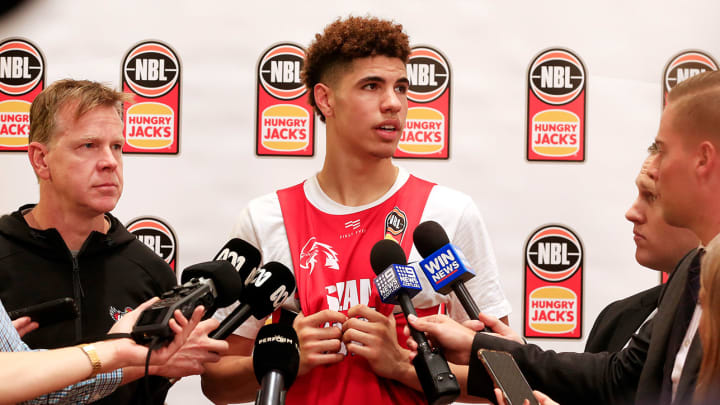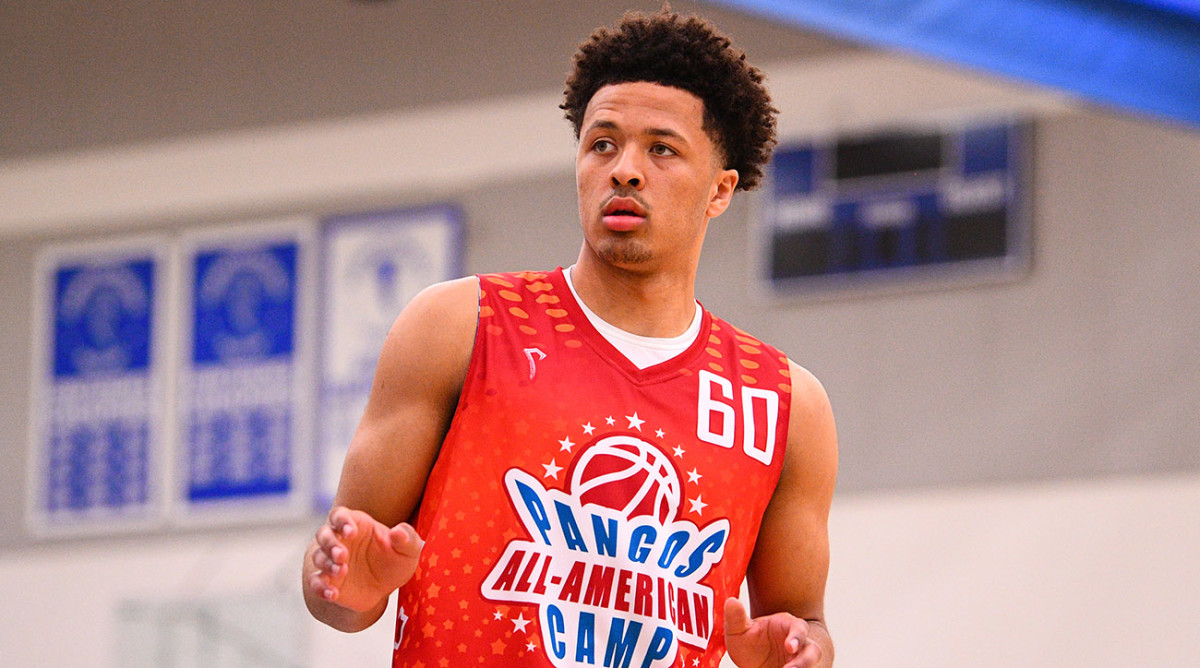NBA Draft Dispatch: LaMelo Ball, Cade Cunningham and What’s Next

August is traditionally a lazy time for basketball, at least from an outward-facing perspective—there’s not much hoop to be found on TV, NBA players remain in various states of vacation, and public debate tends to swirl more around social media posts than anything else (God forbid, today is not Taco Tuesday). But within the basketball industry, the summer months are an essential time for NBA scouts to hit the road, and the primary calendar window for teams to evaluate high school talent at various events around the country. With that in mind, I spent the past two weeks on the ground in California, making stops at UnderArmour’s SC30 Select Camp, the Nike Skills Academy, and at the Drew League pro-am in Los Angeles.
The 2020 draft is next on the horizon, but the 2021 and 2022 drafts are already weighing on the minds of forward-thinking NBA executives. This, of course, is due to the expected change in the league’s age minimum for the 2022 draft, but also thanks to an impressive group of high school-aged prospects that point to a pair of classes that may wind up deeper at the top than we’ve seen in recent years. While there’s a palpable lack of excitement over the upcoming draft, rest assured there’s plenty to look forward to.
So, as we wait out the next two months before the NBA season gets underway, let’s take the opportunity to explore some of what—or rather, who—is on the way.

Start taking LaMelo Ball seriously
I swung by the first round of the Drew League playoffs to watch the youngest Ball brother, who will be part of the 2020 draft class after spending this season in Australia with the Illawarra Hawks. I hadn’t seen him in person since his freshman year of high school at Chino Hills, where he was playing up a grade in order to team with older brothers Lonzo and LiAngelo as part of one of the more entertaining high school teams in recent memory. Admittedly, my expectations weren’t high, particularly trying to evaluate LaMelo in a competitive but unstructured pro-am setting. As it turned out, it was difficult to not walk away extremely enthused by what I’d seen, caveats and all.
This is bad news for NBA teams still dealing with LaVar fatigue, but it’s entirely possible LaMelo ends up being the best player in his family. It took very little time to recognize that from a pure offensive skill standpoint, LaMelo, now 18 years old and standing a legit 6’6”, is much further along as a scorer than Lonzo was at the same stage. Throwing the stats from the game out (honestly, I made a point of not looking at them) and focusing purely on what he does well, it was evident LaMelo possesses much more natural shake and change of pace off the dribble, and while his jumper is still unorthodox, it’s a quicker, cleaner release that he’s able to get to much more comfortably than his brother. The youngest Ball is also an extremely impressive passer, consistently hitting ahead in transition, delivering crisp pocket passes to the screener in pick-and-roll situations, and facilitating team-wide ball movement with his play. He’s not a stellar athlete, but his ability to move the ball and relocate without it points to a great deal of understanding, and makes his strengths feel translatable on a base level.
All that sounds admittedly flowery, and at a glance, Ball has a very tangible chance to be a lottery pick, particularly in a guard-driven 2020 draft that nobody seems remotely excited about. I don’t doubt that his skill set will eventually play up against better competition, although the NBL will be a big physical test, and it’ll be curious what type of minutes and how much offensive volume Ball actually logs for Illawarra this season. What we can’t know relative to Lonzo (who is simply a convenient point of comparison) is whether LaMelo can match his brother’s all-around impact, particularly on defense. If he doesn’t (and he probably won’t), it places more emphasis on him being able to shoot an agreeable percentage from three while facilitating efficient team-wide offense. They share literal DNA, as well as basketball DNA, but LaMelo is clearly the more scoring oriented of the two, but if he can continue to strike an appropriate balance between scoring and playmaking, it would seem he has a chance to be better. This is all relative, and the jury’s far from out on how good Lonzo ends up being, so take it for what it is—the point is that LaMelo looks like a player teams will need to take very seriously (if they aren’t already). For now, we’ll leave it at that.

Make way for Cade Cunningham
I’ve alluded at previous junctures over the past six months to my substantial excitement over Cunningham and will continue to try and refrain from going full-on love letter, but he’s quite clearly the most NBA-ready American guard prospect to come along in quite some time, and in the minds of many NBA executives, the rising high school senior become the early front-runner for the top spot in the 2021 draft. After scouting him with Montverde Academy on four separate occasions during the season, it was rather obvious that Cunningham was being undervalued in the national rankings. His summer performances corrected that in a big way, with a series of strong showings on the EYBL circuit and a leading role as one of the younger players on an American team that won gold at the Under-19 World Cup in Greece. After all that, he showed up to play once again at the Nike Academy in Thousand Oaks, and essentially affirmed what we’d already come to know: everything he does contributes directly to winning basketball, and that winning seems to what he truly cares about.
There’s some ongoing debate nationally as to who the best high school prospect is regardless of class, with 15-year-old standout Emoni Bates holding that title in the minds of some evaluators, and some ranking USC-committed Evan Mobley ahead of Cunningham in his own class. In my opinion, Cunningham is an easy answer to the question, given that he’s safely further along in his physical development, and that there is real substance behind his savant-like understanding of how to play the game. The 6’7” Cunningham grew up playing as a big before successfully converting to lead guard as his full-time role, which lends his game a positionless quality and has granted him a strong understanding of not only his own job, but the roles and responsibilities of his teammates at a given moment. “Directing traffic” is a common cliché for point guards, but Cunningham spends a lot of time literally communicating to help his his team space the floor and run offense efficiently, both with and without the ball in his hands. That his peers so willingly listen and defer to him at an early stage is a testament to his decision-making, passing ability and overall unselfishness. Those abilities help him command trust from others, and create a winning environment where players can give the ball up, knowing they’re eventually going to get it back.
Cunningham has room for improvement as a three-point shooter, as an off-dribble player in space, and is more of a passive team-oriented defender than aggressive on-ball stopper, but his current trajectory gives him such a strong baseline in nearly every area that it’s difficult to see how he fails, as long as he continues working. There’s a misconception that players who are polished at an early age lack long-term upside—just look at Luka Doncic, who’s an interesting analog and supplied substantial value for Dallas as a 19-year-old rookie. I’d argue that the way Cunningham appears to be wired actually creates that type of star potential. It’s exceedingly difficult to be a legitimate, high-usage playmaker that can anchor a winning NBA offense, but Cunningham’s trajectory is pointing firmly in that direction, a label that cannot responsibly be attached to any other prospect in high school basketball at this stage. His floor seems unbelievably reliable, and wherever he attends college, be it Oklahoma State (where his brother is now on staff) or a blue blood like Kentucky or North Carolina, his stay will be brief, and the hype train will eventually follow. Right now, Cunningham looks like the big prize in 2021, and barring the unforeseen, over the next couple years, it will be hard to convince me otherwise.
The “Double Draft” may not be that big a deal
Understandably, there’s been a lot of commotion over the NBA’s likely shift in age minimum, which seems set to allow the 2022 high school class to jump directly to the pros, creating a 2022 draft that includes elite players from that class in addition to the one-and-done crop from 2021. That group of players is still in a relatively nascent stage, and beyond Bates, who many are already pegging to hold the top spot and be the No. 1 pick in ‘22, it’s not particularly easy to project that far ahead. But with the way things have begun to shape up, there’s a very real chance that the 2021 draft actually ends up being deeper in all facets.
That scenario is due largely to the strength of the 2020 high school class, which includes a notably strong collection of prospects headlined by Cunningham and Evan Mobley, and with likely one-and-dones like Jalen Johnson and Jalen Green not too far behind. There’s also likelihood we see highly-regarded 2021 prospects Jonathan Kuminga (the consensus top player in that class) and Terrence Clarke end up reclassifying to join that group (into which they fit more closely age-wise) one way or another. Factor in the presence of guys like Brandon Boston (committed to Kentucky), Daishen Nix (bound for UCLA) a group of bigs that includes, Isaiah Todd, Scottie Barnes and Greg Brown, and a host of others with legitimate NBA potential, and this might end up as far and away the deepest incoming group of college freshmen in years. And conceivably, more high-level players on the age cusp could try and reclassify as an attempt to avoid being buried in the 2022 draft. This is good news for teams like Boston, New Orleans, New York and Oklahoma City, all of whom could conceivably end up with multiple first-round selections in the 2021 draft.
While this situation is still amorphous and will rather obviously shift as time passes and the statuses of individual players clarify, it’s a relevant one as the season approaches and draft picks continue to change hands. While teams have been open-minded in dealing 2020 firsts, and the contractual slot salary attached to first-round selections continues to rise with the cap number, valuations of future firsts could be back on the upswing, given what might be coming.
